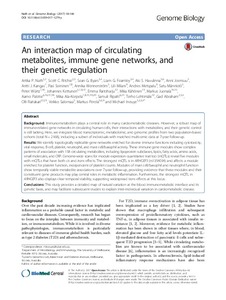An interaction map of circulating metabolites, immune gene networks, and their genetic regulation
Nath AP; Ritchie SC; Byars SG; Fearnley LG; Havulinna AS; Joensuu A; Kangas AJ; Soininen P; Wennerstrom A; Milani L; Metspalu A; Mannisto S; Wurtz P; Kettunen J; Raitoharju E; Kahonen M; Juonala M; Palotie A; Ala-Korpela M; Ripatti S; Lehtimaki T; Juonala M; Raitakari O; Salomaa V; Perola M; Inouye M
An interaction map of circulating metabolites, immune gene networks, and their genetic regulation
Nath AP
Ritchie SC
Byars SG
Fearnley LG
Havulinna AS
Joensuu A
Kangas AJ
Soininen P
Wennerstrom A
Milani L
Metspalu A
Mannisto S
Wurtz P
Kettunen J
Raitoharju E
Kahonen M
Juonala M
Palotie A
Ala-Korpela M
Ripatti S
Lehtimaki T
Juonala M
Raitakari O
Salomaa V
Perola M
Inouye M
BIOMED CENTRAL LTD
Julkaisun pysyvä osoite on:
https://urn.fi/URN:NBN:fi-fe2021042717074
https://urn.fi/URN:NBN:fi-fe2021042717074
Tiivistelmä
Background: Immunometabolism plays a central role in many cardiometabolic diseases. However, a robust map of immune-related gene networks in circulating human cells, their interactions with metabolites, and their genetic control is still lacking. Here, we integrate blood transcriptomic, metabolomic, and genomic profiles from two population-based cohorts (total N = 2168), including a subset of individuals with matched multi-omic data at 7-year follow-up.Results: We identify topologically replicable gene networks enriched for diverse immune functions including cytotoxicity, viral response, B cell, platelet, neutrophil, and mast cell/basophil activity. These immune gene modules show complex patterns of association with 158 circulating metabolites, including lipoprotein subclasses, lipids, fatty acids, amino acids, small molecules, and CRP. Genome-wide scans for module expression quantitative trait loci (mQTLs) reveal five modules with mQTLs that have both cis and trans effects. The strongest mQTL is in ARHGEF3 (rs1354034) and affects a module enriched for platelet function, independent of platelet counts. Modules of mast cell/basophil and neutrophil function show temporally stable metabolite associations over 7-year follow-up, providing evidence that these modules and their constituent gene products may play central roles in metabolic inflammation. Furthermore, the strongest mQTL in ARHGEF3 also displays clear temporal stability, supporting widespread trans effects at this locus.Conclusions: This study provides a detailed map of natural variation at the blood immunometabolic interface and its genetic basis, and may facilitate subsequent studies to explain inter-individual variation in cardiometabolic disease.
Kokoelmat
- Rinnakkaistallenteet [27094]
